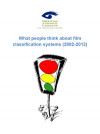The purpose of this literature review was to compare New Zealander's views of classification and rating labelling systems with overseas respondents' views from research published in the past 10 years (2002-2012). Published research was collected primarily from agencies in Britain, Ireland, the United States, and Australia.
Purpose
The purpose of this review is:
- to compare New Zealander’s views of classification and rating labelling systems with overseas respondents’ views from research published in the past 10 years (2002-2012)
- to understand the kinds of classification and rating labelling systems that people think best communicate the intended protective or warning information to film and game audiences
- to help inform us about classification system changes and trends in other countries
- as a reference for future developments in the New Zealand classification system
Methodology
A search for relevant research was conducted using:
- internet search engines (Google and Google Scholar)
- the Classification Office library database
- databases accessed via Wellington City Libraries (www.mygateway.info)
- document research websites
- websites of media/classification authorities
Some examples of search terms used:
- “film/movie/video”
- “label/labels/labelling”
- “classification/s”
- “rating/s”
- “research” “survey” etc
Research was confined to the last 10 years because:
- most of the research at least partly analogous to the kind of research (general/public opinion) we did in 2007 and 2011 was from the period 2002-2012
- this time period was long enough to include repeat research from the same organisations allowing for comparisons over time
- the nature of the entertainment industry (and how classification systems relate to it) has changed rapidly in the last ten years therefore research becomes less relevant beyond a 10-year timeframe
The original scope of the review included research published in academic journals. However, the research most relevant for this review was either commissioned by or carried out by:
- ratings/classification regulatory agencies themselves (such as the BBFC)
- other government agencies with regulatory role (such as the FTC)
- other industry groups with regulatory role (such as ISFE)
Research previously published by the Classification Office was also used.
Key Results
Public awareness and support
- Awareness and understanding of classification and rating labelling systems varies substantially, however, New Zealanders have a high level of awareness and understanding of their classification labelling system.
- Overseas agencies, and the classification or rating labels they assign, generally have strong support from the public. The Classification Office in New Zealand maintains a high level of public support relative to other jurisdictions.
- Parents in the jurisdictions examined, and in particular parents with younger children, tend to be more supportive of, and are more likely to rely on, classification and rating labelling systems than the public in general. This is also true in New Zealand.
Perceptions of classifications
- As in New Zealand, men in other jurisdictions are more likely to think classification and rating decisions are too strict, and women to think that they are too lenient.
- Young people generally support classification and rating labelling systems, but are also more likely to consider the decisions overly strict.
- Young people are less likely than the public in general to consider classifications or ratings influential in their entertainment choices.
What works and what doesn’t
- In New Zealand, as elsewhere, ‘mid-level’ classifications (such as ‘M’) and variations of similar classifications (such as ‘12A’ and ‘12’) tend to be less well understood, and people tend to be less supportive of them.
- Research into public understanding and recommendations about content advice on classification labels suggests that the New Zealand descriptive note format is effective relative to other jurisdictions.
- People generally support application of a single set of rating or classification labels regardless of the entertainment format.
What concerns
- There is wide agreement that certain content is likely to be harmful, especially to children and young people.
- People tend to see violence in film and video games differently.
- In some countries, depictions of drug use are considered the most important content of concern in terms of classification labelling decisions.
Who’s responsible?
- People generally agree that certain content should be age-restricted, but there is significant disagreement over whether parents or industry or the state should enforce restrictions.

